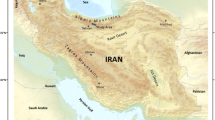Conclusions
-
1.
The anomalies of the seepage regime of the Mingechaur hydraulic-fill dam established during on-site observations are not related to intensification of the seepage flow and at present do not pose a danger for operation of the structure within the normal pool level of the reservoir, 83.0 m, which is also indicated by the temporal constancy of the seepage discharge being intercepted by the toe drain. The static calculations of slope stability under various most unfavorable operating conditions and an investigation of its earthquake resistance show a safe condition of the dam.
-
2.
To judge from the results of investigating the soils of the core zone in the upper part, the Mingechaur hydraulic-fill dam in its current condition should be regarded not as a core-wall dam but as a gravel-sand dam with a lean central zone. About 10 such hydraulicfill dams, although of smaller height, have been constructed in the Soviet Union (Plyavinyas, Dubossary, Kaunas, etc.).
-
3.
The presence of layers of increased permeability in the upper part of the core zone and the very high values of the permeability coefficient (up to 50 m/day) within the coreless “cap” of the dam (above elevation 84.0 m) give rise to the probability of a substantial increase of seepage discharge in the case of raising the level above the normal at reservoir elevations within 83.00–85.50, which can cause overfilling of the drainage system. At the same time we cannot preclude the possibility of the occurrence of contact erosion on the crest of the core zone under these operating conditions. With consideration of the aforesaid, it is recommended to take the elevation of the maximum water level with some margin equal to 83.50 m (the design specified 85.50 m).
-
4.
To ensure safe operating conditions of the Mingechaur hydropower development at the designed maximum operating level above the elevation of the normal reservoir level of 83.0 m, it is required to strengthen the upper part of the core zone and “cap” by creating a watertight barrier. The design of the barrier should be selected on the basis of a technical and economic comparison of possible variants.
In connection with the great excess of the dam crest over the existing NPL (8.0 m), after strengthening the dam the question of raising the NPL by 3–4 m can be examined, which at a relatively small cost of the structures can create an additional water supply in the Mingechaur reservoir (more than 2.0 km3) for expanding irrigation agriculture in the Kura valley of Azerbaidzhan.
Similar content being viewed by others
Literature cited
V. E. Domanskii, Construction of the Mingechaur Complex of Hydraulic Structures [in Russian], Gosénergoizdat, Moscow (1960).
R. B. Taraverdiev, Siltation of the Mingechaur Reservoir [in Russian], ÉLM, Baku (1974).
Geology and Dams [in Russian], Vol. 1, Gosénergoizdat, Moscow (1959).
A. A. Zvontsov, Hydraulic Filling of the Mingechaur Dam [in Russian], Gosénergoizdat, Moscow (1955).
L. M. Bosovskii, Hydraulic Filling of a Large Earth Dam with a Central Core [in Russian], Gosénergoizdat, Moscow (1958).
V. A. Melent'ev, N. P. Kolpashnikov, and B. A. Volnin, Hydraulic-Fill Structures [in Russian], Énergiya, Moscow (1973).
Instructions on the Design of Transition Zones of Rockfill Dams. VNS 47-71 [in Russian], Énergiya (1971).
Guide to the Design of Graded Filters of Hydraulic Structures. II 92-80 [in Russian], VNIIG (1981).
Guide to the Technology of Constructing Rockfill Dams with Sand Infilling of Voids. II 97–81 [in Russian] (1982).
SNiP II-53-73. Earth Dams [in Russian], Stroiizdat (1974).
Instructions on Calculating the Stability of Earth Slopes. VSN-04-71 [in Russian], Énergiya (1971).
Methods of Calculating the Stability of Earth Slopes on an ÉVM-200 Computer (“RUMKÉ” Program) [in Russian], Informénergo, Bibl. Ukazatel' VINITI, No. 7 (1979).
Additional information
Translated from Gidrotekhnicheskoe Stroitel'stvo, No. 1, pp. 3–8, January, 1984.
Rights and permissions
About this article
Cite this article
Melent'ev, V.A., Nosovova, O.N., Mityushina, I.M. et al. Seepage regime of the hydraulic-fill dam of the mingechaur hydropower development. Hydrotechnical Construction 18, 1–8 (1984). https://doi.org/10.1007/BF01432865
Issue Date:
DOI: https://doi.org/10.1007/BF01432865




